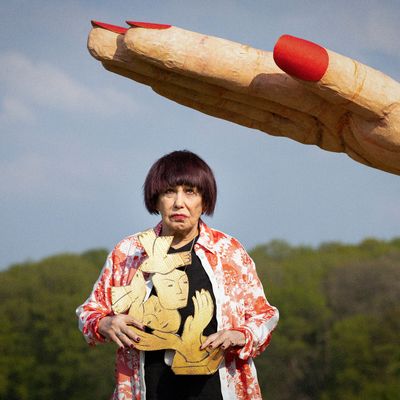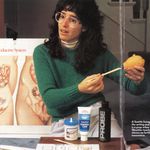
The great Agnès Varda documentary The Gleaners and I, released in the year 2000, launched a new phase in the director’s career — and, along with it, a spike in public recognition. She was already known in cinephile circles as the lone woman to be associated with the French New Wave — the 1962 film Cléo from 5 to 7 is perhaps her most famous contribution, but she continued to oscillate between features and documentaries for decades — yet she wasn’t widely celebrated until the 21st century, when her presence in front of the camera made her an icon in much the same way it did Werner Herzog, who was already parodied by Documentary Now! earlier this season. Varda came to represent many things at once: curiosity, whimsy, toughness, and an inspiring persistence of vision after over a half-century of making movies.
The Gleaners and I is about the treasures you find in the trash, those discarded items that “gleaners” of all kinds can rescue from dumpsters, harvested farmlands, and, of course, life itself. With such an elastic conceit, Varda freed herself to be a kind of philosophical adventurer, traveling wherever her instincts took her, whether that meant a far-flung location or some poetic thought that had crossed her mind. And audiences loved her for it. I happened to see The Gleaners and I at a public screening at the Toronto International Film Festival in 2000, and at the Q&A that followed, Varda’s scavengers passed out various cakes and treats that had been rescued from the garbage. She couldn’t have delighted the crowd more.
At the same time, Varda also became a mascot of sorts: the adorable, diminutive old eccentric with the bowl haircut, every bit as meme-friendly as Herzog. It comes as a relief that “Trouver Frisson,” the last and perhaps best episode of this great season of Documentary Now!, pokes affectionately at the odd musings of her work while also acknowledging that she wasn’t to be reduced to some cute old lady. You don’t move within the male-exclusive circles of Godard, Truffaut, and Rohmer without the same artistic and political restlessness, and you don’t keep making relevant movies well into your 80s without grit. The warmth of a film like The Gleaners and I is unmistakable, but sentimentality was never Varda’s purpose.
“Trouver Frisson” backs into its thesis in a hilariously Varda-like way, with filmmaker Ida Leos reflecting on the stain growing on her ceiling, which she renders artfully in stop motion. “The skin is the wallpaper of the body and the wallpaper is the skin of the wall,” she says. “This metaphor is so circular that to say it aloud is to waste your time.” But within that rotting ceiling — which turns out to be a literal health hazard that drives her from her home — Ida lands on a sober assessment of her own decay, which is affecting not only her body, but also her joie de vivre. Her translucent wallpaper-skin doesn’t burst with goosebumps as it did in her youth. She would have to go searching for her lost “frisson.”
As played by Lillian Rovère — a decades-spanning French icon in her own right, having appeared in films by Chantal Akerman and both Bertrands, Blier and Tavernier — Ida is depicted as an artist who is so obsessed with her work that the everyday practicalities are a mystery to her. The stain she sees as “strange and beautiful” on her ceiling is, to her handyman Jean-Paul, simply black mold that must be remediated. And when she decides to go to her childhood home in search of her youthful frisson, she seems to feel like her artistic mission justifies a casual breaking-and-entering. After the front door won’t budge, she tries with little success to squeeze through an open window.
The scene that unfolds at that childhood home typifies the multilayered pleasures of “Trouver Frisson.” The house’s current occupants, Guillaume and Celine, are a story in themselves, with Ida’s camera catching Celine’s suppressed hostility as her husband natters on about his collection of painted ducks. (“He paints an awful lot of them,” says Celine, her eyes an abyss of despair.) Ida’s attempt to summon the feeling of getting kissed in her bedroom leads to a hastily improvised re-creation with a pretty young French actress and Guillaume, who steps in for an actor who got lost trying to find the place. The makeout session doesn’t please Ida (“I feel nothing. Cut.”), but at least Guillaume gets to play the scene for all it’s worth.
Another sequence where Ida visits an actual town called Frisson, which has made a kind of quaint tourist trap out of joy, is funny mostly because of a resident who finds frisson by having sex with strangers. But the heart of “Trouver Frisson” is Ida’s relationship to Pierre Mouland, an aging New Wave legend meant to evoke Jean-Luc Godard. The real Godard had played a silent, sinister role in Varda and street artist JR’s wonderful 2017 documentary, Faces Places. In the middle of visiting various French towns and transforming them through large portraits, Varda muses on a short she made with Godard in 1961 and arranges to take JR with her to Switzerland to meet him. When they show up, Godard refuses to see them, leaving Varda genuinely hurt (and factions of the film internet angry at Godard).
“Trouver Frisson” imagines a happier reunion, though maybe not for Godard, who didn’t seem like the kind of person who would do well at a retirement home. Here, Ida and Mouland, once “Cahiers du Cinema’s sexiest director of 1962,” reminisce about the time they co-starred in his New Wave classic The Philosophical Layabouts and picked through his collection of sunglasses, which include “The Lolitas,” “The Fellinis,” and “The Blues Brothers.” Ida’s whimsical idea to bring the town of Frisson to the retirement home — complete with the woman who has sex with strangers — leads to a genuinely sweet moment when she leads Mouland through a re-creation of the musical robbery sequence they did together in The Philosophical Layabouts. It still doesn’t do much for her, but she decides that giving joy to others is a fine enough consolation prize.
The writers and directors of “Trouver Frisson” get the rhythms and tone of Varda’s late, digital documentaries right, but they also pointedly refuse to make Ida into the harmless, edgeless old woman, a stereotype applied to Varda in some circles. A scene in which Ida accepts a Lifetime Achievement award at a film festival from a model who pats her on the head and calls her “adorable” leads her to despair. “I’d rather die,” she says, then get thought about as “cute,” and she stages a bit where she gets patted on the head by a giant papier-mâché hand and then buries herself in the ground. Agnès Varda was a personable, playful, and, yes, lovable human being, but she was no one’s dotty old nana.
B-Roll
• “The Fun Wheel,” a 13th-century invention for children to take their minds off the summer plague! It does not do much for poor Ida, however.
• The bit where Ida is on the freeway crushing trucks with her hands is taken directly from The Gleaners and I (and perhaps the “I’m crushing your head” sketch from The Kids in the Hall.) There’s no more memorable quote from Varda than this one: “My hair and hands keep telling me the end is near.” It turns out the end would be nearly 20 years later.
• Ida trying to fit into the window: “The past is elusive and the opening is small.”
• Life at a retirement home: “The hypnotic turn of wheelchair spokes. The soft patter of opioids filling a plastic cup. The creamy pungency of day-old mashed potatoes.”
• The cut from Ida and Mouland dancing as a distraction for the bank robbery in The Philosophical Layabouts to them dashing through the streets, joyfully flinging the cash in the air, is both a funny nod to the jump cuts on Godard’s work and a way of getting out of showing how the robbery itself might have gone down.
• Ida’s assessment of stock images of elderly people smiling and having fun: “Decidedly unerotic. Synthetic frisson.” True that.
• Petitioning for a side project about the butcher from outside Fort Wayne, Indiana, who runs the sausage shop in Frisson and enjoys “hacking stuff up.” Ditto the accordionist who likes Iron Maiden.
• Great button at the end of the episode for Ida to be unmoved by any of her efforts to find “goosebumps,” but thrilled by the sight of peeling paint that looks like Charlie Chaplin. “Fucking hell!” she says. “I got frisson!”




